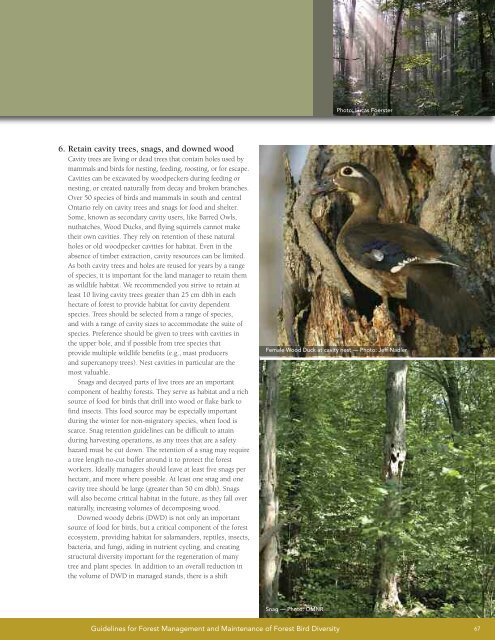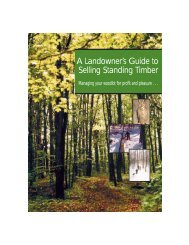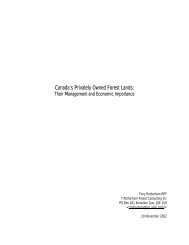A land manager's guide to conserving habitat for forest birds in ...
A land manager's guide to conserving habitat for forest birds in ...
A land manager's guide to conserving habitat for forest birds in ...
You also want an ePaper? Increase the reach of your titles
YUMPU automatically turns print PDFs into web optimized ePapers that Google loves.
Pho<strong>to</strong>: Lucas Foerster<br />
6. Reta<strong>in</strong> cavity trees, snags, and downed wood<br />
Cavity trees are liv<strong>in</strong>g or dead trees that conta<strong>in</strong> holes used by<br />
mammals and <strong>birds</strong> <strong>for</strong> nest<strong>in</strong>g, feed<strong>in</strong>g, roost<strong>in</strong>g, or <strong>for</strong> escape.<br />
Cavities can be excavated by woodpeckers dur<strong>in</strong>g feed<strong>in</strong>g or<br />
nest<strong>in</strong>g, or created naturally from decay and broken branches.<br />
Over 50 species of <strong>birds</strong> and mammals <strong>in</strong> south and central<br />
Ontario rely on cavity trees and snags <strong>for</strong> food and shelter.<br />
Some, known as secondary cavity users, like Barred Owls,<br />
nuthatches, Wood Ducks, and fly<strong>in</strong>g squirrels cannot make<br />
their own cavities. They rely on retention of these natural<br />
holes or old woodpecker cavities <strong>for</strong> <strong>habitat</strong>. Even <strong>in</strong> the<br />
absence of timber extraction, cavity resources can be limited.<br />
As both cavity trees and holes are reused <strong>for</strong> years by a range<br />
of species, it is important <strong>for</strong> the <strong>land</strong> manager <strong>to</strong> reta<strong>in</strong> them<br />
as wildlife <strong>habitat</strong>. We recommended you strive <strong>to</strong> reta<strong>in</strong> at<br />
least 10 liv<strong>in</strong>g cavity trees greater than 25 cm dbh <strong>in</strong> each<br />
hectare of <strong>for</strong>est <strong>to</strong> provide <strong>habitat</strong> <strong>for</strong> cavity dependent<br />
species. Trees should be selected from a range of species,<br />
and with a range of cavity sizes <strong>to</strong> accommodate the suite of<br />
species. Preference should be given <strong>to</strong> trees with cavities <strong>in</strong><br />
the upper bole, and if possible from tree species that<br />
provide multiple wildlife benefits (e.g., mast producers<br />
and supercanopy trees). Nest cavities <strong>in</strong> particular are the<br />
most valuable.<br />
Snags and decayed parts of live trees are an important<br />
component of healthy <strong>for</strong>ests. They serve as <strong>habitat</strong> and a rich<br />
source of food <strong>for</strong> <strong>birds</strong> that drill <strong>in</strong><strong>to</strong> wood or flake bark <strong>to</strong><br />
f<strong>in</strong>d <strong>in</strong>sects. This food source may be especially important<br />
dur<strong>in</strong>g the w<strong>in</strong>ter <strong>for</strong> non-migra<strong>to</strong>ry species, when food is<br />
scarce. Snag retention <strong>guide</strong>l<strong>in</strong>es can be difficult <strong>to</strong> atta<strong>in</strong><br />
dur<strong>in</strong>g harvest<strong>in</strong>g operations, as any trees that are a safety<br />
hazard must be cut down. The retention of a snag may require<br />
a tree length no-cut buffer around it <strong>to</strong> protect the <strong>for</strong>est<br />
workers. Ideally managers should leave at least five snags per<br />
hectare, and more where possible. At least one snag and one<br />
cavity tree should be large (greater than 50 cm dbh). Snags<br />
will also become critical <strong>habitat</strong> <strong>in</strong> the future, as they fall over<br />
naturally, <strong>in</strong>creas<strong>in</strong>g volumes of decompos<strong>in</strong>g wood.<br />
Downed woody debris (DWD) is not only an important<br />
source of food <strong>for</strong> <strong>birds</strong>, but a critical component of the <strong>for</strong>est<br />
ecosystem, provid<strong>in</strong>g <strong>habitat</strong> <strong>for</strong> salamanders, reptiles, <strong>in</strong>sects,<br />
bacteria, and fungi, aid<strong>in</strong>g <strong>in</strong> nutrient cycl<strong>in</strong>g, and creat<strong>in</strong>g<br />
structural diversity important <strong>for</strong> the regeneration of many<br />
tree and plant species. In addition <strong>to</strong> an overall reduction <strong>in</strong><br />
the volume of DWD <strong>in</strong> managed stands, there is a shift<br />
Female Wood Duck at cavity nest — Pho<strong>to</strong>: Jeff Nadler<br />
Snag — Pho<strong>to</strong>: OMNR<br />
Guidel<strong>in</strong>es <strong>for</strong> Forest Management and Ma<strong>in</strong>tenance of Forest Bird Diversity 67

















